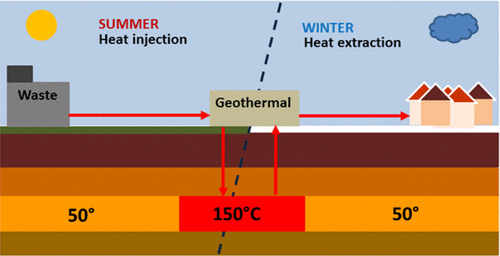当前位置:
X-MOL 学术
›
ACS Earth Space Chem.
›
论文详情
Our official English website, www.x-mol.net, welcomes your feedback! (Note: you will need to create a separate account there.)
Core Flooding Experiments and Reactive Transport Modeling of Seasonal Heat Storage in the Hot Deep Gassum Sandstone Formation
ACS Earth and Space Chemistry ( IF 3.4 ) Pub Date : 2017-06-15 00:00:00 , DOI: 10.1021/acsearthspacechem.7b00031 Hanne D. Holmslykke , Claus Kjøller , Ida L. Fabricius 1
ACS Earth and Space Chemistry ( IF 3.4 ) Pub Date : 2017-06-15 00:00:00 , DOI: 10.1021/acsearthspacechem.7b00031 Hanne D. Holmslykke , Claus Kjøller , Ida L. Fabricius 1
Affiliation

|
Seasonal storage of excess heat in hot deep aquifers is considered to optimize the usage of commonly available energy sources. The chemical effects of heating the Gassum Sandstone Formation to up to 150 °C is investigated by combining laboratory core flooding experiments with petrographic analysis and geochemical modeling. Synthetic formation water is injected into two sets of Gassum Formation samples at 25, 50 (reservoir temperature), 100, and 150 °C with a velocity of 0.05 and 0.1 PV/h, respectively. Results show a significant increase in the aqueous concentration of silicium and iron with increasing temperature due to dissolution of silica and siderite. Increasing the reservoir temperature from 50 to 100 °C enhanced the naturally occurring weathering of Na-rich feldspar to kaolinite. Dissolution of quartz increased sharply above 100 °C and was the dominating process at 150 °C, resulting in a significant increase in the aqueous silicium concentration. At temperatures ≤100 °C, the silicium concentration was controlled by a quasi-stationary state between feldspar dissolution and kaolinite precipitation whereas the concentration was kinetically controlled by quartz dissolution at 150 °C. Furthermore, a strong coupling between dissolution, precipitation, and flow velocity was observed. The results of this study show that the effects of heat storage of up to 150 °C in the Gassum Formation in the Stenlille area is expected to have only minor effects on the properties of the reservoir and that storage of excess heat in the Gassum Formation in the Stenlille area may be possible provided operational precautions are taken.
中文翻译:

深部热气砂岩地层中季节性储热的岩心驱油实验及反应输运模型
季节性在热的深层含水层中多余的热量被认为可以优化常用能源的使用。通过将实验室岩心驱油实验与岩石学分析和地球化学模型相结合,研究了将Gassum砂岩地层加热到150°C的化学作用。将合成地层水分别以0.05和0.1 PV / h的速度注入到25、50(储层温度),100和150°C的两组Gassum地层样品中。结果表明,由于二氧化硅和菱铁矿的溶解,硅和铁的水浓度随温度的升高而显着增加。将储层温度从50°C升高到100°C可以增强自然富钠长石向高岭石的风化作用。高于100°C时,石英的溶解度急剧增加,并且在150°C时是主要过程,从而导致含水硅浓度显着增加。在≤100°C的温度下,长石溶解和高岭石沉淀之间的准静态状态控制着硅的浓度,而在150°C下,石英溶解则动态地控制了硅的浓度。此外,观察到溶解,沉淀和流速之间的强耦合。这项研究的结果表明,在Stenlille地区,Gassum组中高达150°C的储热效应仅对储层的性质有很小的影响,而在2004年Gassum组中,Gassum组中的多余热量的储藏将受到影响。如果采取了操作预防措施,则可能在Stenlille地区。
更新日期:2017-06-15
中文翻译:

深部热气砂岩地层中季节性储热的岩心驱油实验及反应输运模型
季节性在热的深层含水层中多余的热量被认为可以优化常用能源的使用。通过将实验室岩心驱油实验与岩石学分析和地球化学模型相结合,研究了将Gassum砂岩地层加热到150°C的化学作用。将合成地层水分别以0.05和0.1 PV / h的速度注入到25、50(储层温度),100和150°C的两组Gassum地层样品中。结果表明,由于二氧化硅和菱铁矿的溶解,硅和铁的水浓度随温度的升高而显着增加。将储层温度从50°C升高到100°C可以增强自然富钠长石向高岭石的风化作用。高于100°C时,石英的溶解度急剧增加,并且在150°C时是主要过程,从而导致含水硅浓度显着增加。在≤100°C的温度下,长石溶解和高岭石沉淀之间的准静态状态控制着硅的浓度,而在150°C下,石英溶解则动态地控制了硅的浓度。此外,观察到溶解,沉淀和流速之间的强耦合。这项研究的结果表明,在Stenlille地区,Gassum组中高达150°C的储热效应仅对储层的性质有很小的影响,而在2004年Gassum组中,Gassum组中的多余热量的储藏将受到影响。如果采取了操作预防措施,则可能在Stenlille地区。


























 京公网安备 11010802027423号
京公网安备 11010802027423号